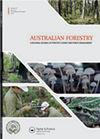3年多苞桉后代生物量和桉树脑产量的遗传参数和育种潜在收益
IF 1.2
4区 农林科学
Q3 FORESTRY
引用次数: 7
摘要
摘要:多苞桉是一种木槌状桉树,除了作为桉树油的来源取得了成功外,它还有可能成为澳大利亚南部旱地农业的多年生生物质作物。来自新南威尔士州西威龙及其周边地区的66个本土开放授粉家庭在西澳大利亚州纽德盖特进行了试验;德拉姆马丁,维多利亚州;以及新南威尔士州的康多博林。Condobolin的增长最快,其次是Drummartin,然后是Newdegate。估计的跨位点遗传相关性在Newdegate和Condobolin之间为rg=0.85±0.16,在Newdegat和Drummartin之间为rg=1.08±0.35,在Condobolin和Drummantin之间为rg=1.03±0.32。估计的增益表明,基因型×环境的相互作用实际上并不显著。生物量产量的狭义遗传力在Newdegate为ĥ2=0.18±0.07,在Drummartin为\293\2=0.05±0.04,在Condobolin为୴2=0.32±0.08。纽德盖特叶片桉叶素浓度的遗传力为ĥ2=0.38±0.09。叶片桉叶素浓度与生物量产量的遗传相关性为rg=0.07±0.19,表型相关性为rp=-0.12±0.03。与对树木生物量或叶片桉叶素浓度的选择相比,当希望最大限度地提高桉叶素产量和生物量产量时,结合整棵树生物量和叶片桉叶醇浓度的指数选择是最有效的。本文章由计算机程序翻译,如有差异,请以英文原文为准。
Genetic parameters and potential gains from breeding for biomass and cineole production in three-year-old Eucalyptus polybractea progeny trials
ABSTRACT Eucalyptus polybractea is a mallee eucalypt with potential use as a perennial biomass crop for dryland agriculture in southern Australia, in addition to its established success as a source of eucalyptus oil. Sixty-six indigenous, open-pollinated families from West Wyalong and surrounds in New South Wales were tested in trials at Newdegate, Western Australia; Drummartin, Victoria; and Condobolin, New South Wales. Growth was fastest at Condobolin, followed by Drummartin then Newdegate. The estimated cross-site genetic correlation was rg = 0.85 ± 0.16 between Newdegate and Condobolin, rg = 1.08 ± 0.35 between Newdegate and Drummartin, and rg = 1.03 ± 0.32 between Condobolin and Drummartin. Estimated gains suggest that genotype × environment interaction was not practically significant. Narrow-sense heritability for biomass production was ĥ2 = 0.18 ± 0.07 at Newdegate, ĥ2 = 0.05 ± 0.04 at Drummartin and ĥ2 = 0.32 ± 0.08 at Condobolin. Heritability of leaf cineole concentration at Newdegate was ĥ2 = 0.38 ± 0.09. The genetic correlation between leaf cineole concentration and biomass production was rg = 0.07 ± 0.19 and the phenotypic correlation was rp = −0.12 ± 0.03. Compared to selection on either tree biomass or leaf cineole concentration, index selection incorporating both whole tree biomass and leaf cineole concentration is most effective when looking to maximise both cineole yield and biomass production.
求助全文
通过发布文献求助,成功后即可免费获取论文全文。
去求助
来源期刊

Australian Forestry
FORESTRY-
CiteScore
3.70
自引率
4.80%
发文量
15
审稿时长
>12 weeks
期刊介绍:
Australian Forestry is published by Taylor & Francis for the Institute of Foresters of Australia (IFA) for scientific, technical, and professional communication relating to forestry in the Asia Pacific.
 求助内容:
求助内容: 应助结果提醒方式:
应助结果提醒方式:


